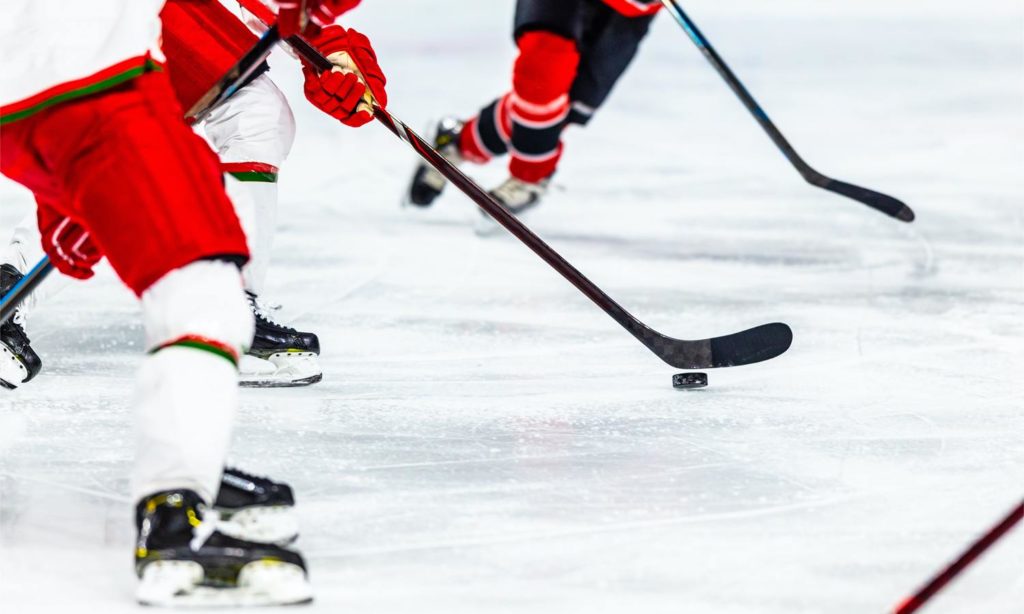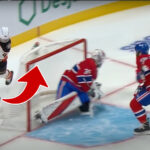As hockey fans, we're always mesmerized by the individual efforts of NHL superstars. We love to see a Connor McDavid highlight where he undresses an unsuspecting defensemen and finishes off by scoring top shelf.
Just for those of you living under a rock, here's a clip that's been played like a broken record on the highlight reels and will likely rank as one of the top NHL plays in 2019-20.
Needless to say Morgan Reilly isn't a fan of this!
However, we need to remember something about hockey...
Hockey is a team sport.
And as for most team sports, passing is a major element of the game.
There are exceptions, such as doubles tennis, where teammates can't actually tap the ball to one another, but they still need to work together to win.
So now that we've established hockey passes are part of team strategy, let's answer our headline question.
Why is passing important in hockey?
Passing is important in hockey because it's the quickest way to move the puck from one player to another on the ice. The puck can be distributed faster than any player can skate.
While teams are on the attack, players can use passing plays to deceive the defending team and force the goaltender to reposition themselves, creating better opportunities to score.
Passing also allows teams to relieve defensive zone pressure and transition to an offensive break out in mere seconds.
This was not always the case in NHL. It took the NHL almost 10 years from inception to discover how passing can revolutionize the game.
So now that we understand why passing is so important, let’s take a look at its history.
History of Passing in the NHL
Originally, when the league was founded in 1910-11 as the National Hockey Association, forward passing was not allowed whatsoever. At the time, players were only allowed to pass the puck behind similar to rugby.
In 1918-19, the league introduced it's first passing rule change along with the creation of the neutral zone. Players were both allowed to make forward passes and kick the puck in the neutral zone alone.
In 1928-29, they expanded the forward passing rule to the defensive zone as well. The one caveat was that players were not allowed to pass the puck back into the defensive once the puck was advanced to the neutral zone. Players were assessed a minor penalty for the infraction.
In 1929-30, forward passing was allowed in all 3 zones, including the offensive zone. The only limitation was that the puck could not be cross either blue lines while attempting a pass.
By December 21, 1929, an amendment was made to the latest passing rule due to the doubling of goals scored in a game. Players were no longer allowed to enter the offensive zone prior to the puck (offside rule).
Two-Line Pass Eliminated
The last major passing rule change made was back in 2005-06 season. Prior to that season, teams were not allowed to pass the puck to a player across both the blue and red (center) line. This was known as the two-line pass and the play was blown dead in the same way as an offside call. The rule change was introduced to increase the pace of the game and create more scoring chances.
Below, I've compiled all the types of hockey passes that can be executed in a hockey game.
Some are situational and illegal passes while most others are descriptions of how the puck can be delivered from carrier to receiver.
List of 28 Hockey Passes (Alphabetical Order)
TYPE OF PASS | DESCRIPTION | |
|---|---|---|
1 | Around-the-boards Pass | A pass completed to a teammate in the offensive or defensive zone using the the contours of the boards. |
2 | Backhand Pass | A pass delivered using the back side of the blade. |
3 | Bank Pass | A pass purposely banked off the boards. |
4 | Between-the-legs Pass | A pass made between the legs of the puck carrier. |
5 | Centering Pass | A pass made towards middle of the ice. |
6 | Chip Pass | A pass made by chipping the ice underneath the puck. The puck can also be chipped off the boards or glass. |
7 | Clearing Pass | A Situational pass whereby the carrier passes the puck from the defensive to neutral zone, often to relieve opposing team pressure. |
8 | Cross Seam Pass | An East-West pass (or vice-versa) made to a player in the gaps of the opposing team coverage. Typically, this type of pass is executed in the offensive zone. |
9 | Drop Pass | A pass left to the player behind you. The original puck carrier can direct the backwards pass or simply stop the puck leaving it for the trailing player. |
10 | Flip Pass | An aerial pass whereby the puck flips like a change in a coin toss. |
11 | Forehand Pass | A pass delivered with the front end of the blade. |
12 | Give-and-go Pass | This play involves passes between two teammates. The puck is passed to the receiver with the intent of giving the puck right back to the original carrier. |
13 | Hand Pass | As in its name, this pass is delivered using the players hand (or glove). Typically, this pass is illegal except if made from one player to another within the defensive zone. |
14 | Head Man Pass | Situational pass whereby the puck is passed to a player ahead of the carrier. The receiver may be in motion or stationary. |
15 | Kick Pass (skate) | A pass delivered to another player using distinctive kicking motion with their skate. |
16 | No-look Pass (Blind) | A pass delivered by the puck carrier to a teammate out of their field of vision. Also known as a blind pass. In some cases, the pass can be made behind back of the puck carrier. |
17 | No-touch Pass | This pass was made famous by Mario Lemieux in the 2002 Olympics. Basically, Lemieux made a sweeping motion with his stick while intentionally avoiding contact with the puck altogether. See Video for explanation. |
18 | One-touch Pass | A pass delivered whereby a player redirects a moving puck to a teammate with slight motion of the stick or blade. |
19 | Rebound Pass | This involves the carrier to shoot the puck on net with the sole intent of creating a rebound for their teammate. Should the teammate score, the original puck carrier will be credited with an assist. |
20 | Redirect (with skate) | Very similar to a kick pass, except there is no distinctive kicking motion involved. Instead, the puck is redirected at an angle using the skate. |
21 | Saucer Pass | An aerial pass whereby the puck spins like a flying saucer. |
22 | Slap Pass | A deception play whereby the carrier slaps the puck over to a teammate. Mostly, the original player attempts to mask it as a slap shot on net. |
23 | Snap Pass | Similar to the slap pass, the carrier snaps the puck over to a teammate. The original player may deceive the opponents into thinking they're attempting a shot on net. |
24 | Stretch Pass | A long pass delivered from the defensive end to a teammate on the rush, normally deep in the neutral zone, close to the opposing team’s blue line. Also known as a long bomb or hailmary (in reference to the American Football offensive throw). The stretch play can also be described as a seam pass if delivered in a gap area of the defensive coverage. |
25 | Sweep Pass | A standard forehand pass whereby the carrier sweeps their stick to complete a pass. In this case, the puck never leaves the surface of the ice. |
26 | Tape-to-tape Pass | A pass completion whereby the carrier delivers a puck from the tape of their stick to the tape of the receiver's stick. |
27 | Tip Pass | A pass delivered to a teammate by redirecting a moving puck. |
28 | Two-line Pass | This pass was illegal prior to the 2005-06 NHL season. It consists of feeding the puck to a teammate on the breakout by passing the puck both across the blue and red line (defensive half of the neutral zone) |
In some cases, a passing play can fall under many categories. One great example is the pass by Erik Karlsson to Mike Hoffman just a couple of seasons ago.
If you analyze the play carefully, the pass can be described as a clearing, saucer and tape-to-tape pass all at once.
There was also another pass made famous by Mario Lemieux. In fact, this was a deception play where Lemieux never even touched the puck. It was coined as the no-touch pass.
See for yourself... This is what a player with high hockey IQ looks like.
Mario Lemieux. Legend!
Which is the hardest hockey pass to master?
The hardest pass to master from the list above is also the pass most frequently attempted in a game - the saucer pass.
Most players will quickly learn to deliver this type of pass while initially developing their game. The pass comes naturally off the carrier's stick and is so effective because it causes the puck to hit the surface flat once it lands. This allows the receiver to easily secure the puck for possession.
However, the carrier is required to properly judge distance, speed and the height to complete the pass. Try feathering a saucer pass at a short distance so that it lands perfectly to a receiver for a one-timer.
See the video example below where Evgeni Malkin delivers a picture-perfect saucer to Phil Kessel.
Did I forget to mention you need to get the right height to avoid turning over the puck to your opponent?
There are many other passes that can pose a challenge, but are almost never needed during play.
I'm thinking about between-the-legs and no-look passes. Tough to execute, but usually not required.
What was the greatest pass ever made?
Obviously, this will all come down to your own taste. Fortunately, the NHL compiled their Top 10 Assists of All Time. Watch the video here:
In my opinion, Mario Lemieux’s play at #5 looked absolutely amazing (starting at 2:15). The fact that he performed a toe drag prior to delivering that laser beam backhand pass is what makes it even more ridiculous.
Some may argue that the Karlsson long bomb (see video above) deserves consideration should the list be updated to today. Keep in mind that this top 10 video was published back in 2013.
However, you may recall Peter Forsberg dished a similar hail mary to Rob Blake a few years back (see here). Except that Karlsson’s saucer pass landed square on Hoffman’s blade, as if the puck were on a string.
Who is the greatest passer of all time?
Drum roll please…
Well, it’s actually a no-brainer for me - Wayne Gretzky. Simply because he has more assists than any player has total career points (which include goals). His ability to read and anticipate play was second to none.
He averaged close to 2 points per game over his career. It's as if he could score or set up his teammates to score at will.
Wayne Gretzky: 1963 Assists (2857 Pts)
Jaromir Jagr: 1921 Pts (#2 in All Time Leading Scoring)
If you were to ask me who's the best passer (playmaker) in today’s NHL, my answer is - without a doubt - Sidney Crosby. Just take a look at this no-look, between-the-legs passing play. In fact, you can add drop pass to the description as well.
The last time that Teddy Blueger (#53) was in Crosby’s field of vision was at the blue line. It’s just crazy how he knew exactly where to pass the puck and anticipated his teammate being in position. It's no surprise that Sidney Crosby will end his career as another one of the all time greats and amongst the top scoring leaders.
In my opinion, the most elite players are those that can make everyone around them better. It's why passing is so important to the game of hockey.
Conclusion
There is so much that we covered on the topic of hockey passes.
We looked at its history in the NHL and learned how changes to the rules of passing lead to more goals being scored.
Furthermore, we learned about 28 passes every player can master. And as your game progresses, you can add many of these to your playmaking arsenal.
If you're a beginner and reading this, I suggest you start with the basics. Since I didn't clarify earlier which passes you should start with, I'll list them here:
Once you've master these passes, most of the other ones will come to you naturally.
Others types on the list are very high risk passes (i.e. behind the back, between the legs). One badly executed pass can result in a turnover and possibly a goal against.
If you ever want to test your capabilities, you're better trying them in the offensive zone only. Try out the give-and-go or a centering pass to a player in the slot.
Just make sure you're never the last man back as it never ends well.
If you're an avid rec league player, you might be interested to read about my list of 11 Subtle Tips on How to Player Beer League Hockey. One of the tips emphasizes on passing and when to execute depending on the situation.
Is there any other reason why you consider passing to be important? Can you name any other types of passes that were not included in the list?
Please leave a comment below.






